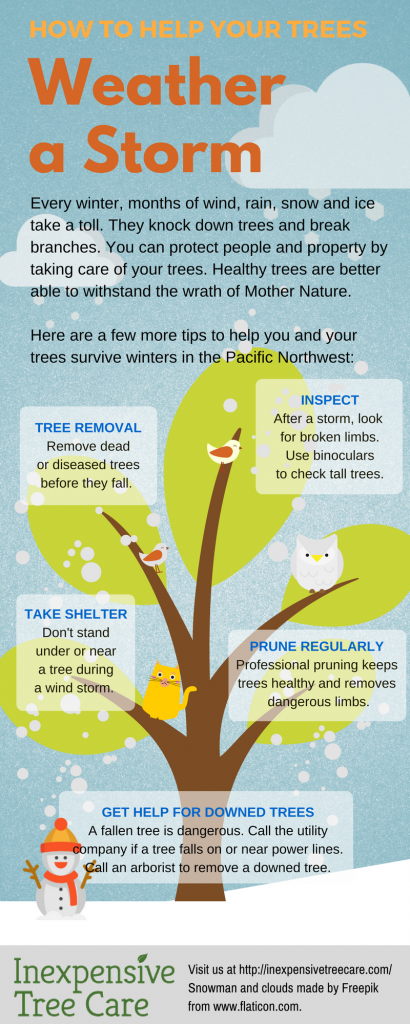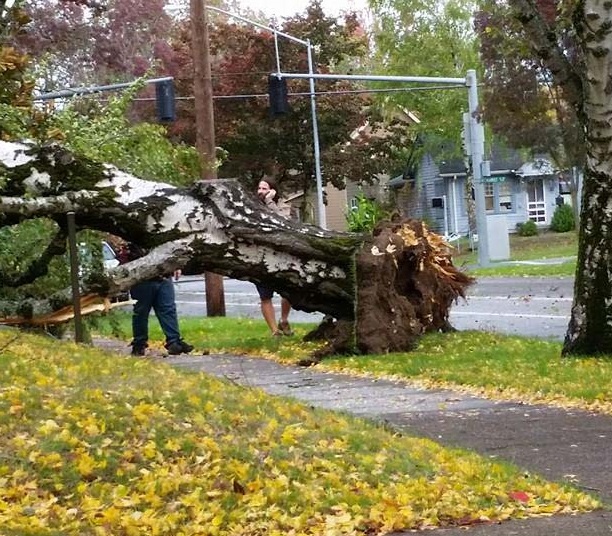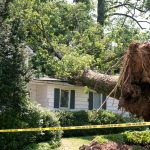How to Deal with Storm Damaged Trees

Updated Dec 11, 2017
Mature trees look like they can stand up to anything. Most of the time, they do. But, a big Pacific Northwest storm can damage even the sturdiest of these tall beauties. You can give a tree a better chance of surviving if you take care of it with regular pruning. Here’s how to help trees weather a storm and assess the health of storm damaged trees.
Inspect Trees Before a Storm
Before a storm, take a close look at your trees. Check for signs of damage or illness. If you see any the following, there could be trouble:
- Cracks in large branches or the tree trunk
- Decay or disease anywhere in the tree
- A hollow area in the trunk
- A tree that leans
- Branches hanging over of a building
- Trees close to power lines
- Mushroom and fungi growing on trees
If you can’t inspect a tree yourself, call us for help. We’ll assess your tree’s health. Learn more about recognizing a hazardous tree.
Preventative Measures for Storm Damaged Trees
If you see a problem with a tree, we may be able to help. It’s best to eliminate small problems before they turn into big ones. Here are some things that can help storm damaged trees:
- Prune dead, damaged or diseased branches
- Trim excess growth
- Remove hazardous trees
- Remove branches that hang over your house or the street
- Have a professional remove or trim a tree that’s close to a power line
It’s best to hire us to prune, trim or remove a tree in Portland. Mature tree branches are dangerous and heavy. If a tree is young, and you don’t need a ladder to work, you may be able to do the pruning yourself.
What to Do After a Storm
Once the storm passes, you can assess the damage. Use extreme caution as you look at your trees. It’s easy to miss broken branches caught high in the canopy. If you see a power line on the ground or in a tree, stay well away and call the power company. If you’re not sure if a tree made it through OK, we can check it for damage.
If a storm damaged tree has fallen or looks unstable, we can help with tree removal in Portland and the surrounding area. Once the tree is gone, we’ll get rid of the ugly stump by grinding it into sawdust. Learn more about dealing with storm damaged trees.
Storms can strike at any time and undermine the integrity of even the strongest trees. In the event that a tree you enjoy incurs storm damage, follow these steps to ensure your safety and help you decide what further decisions to make about removal.
Assessing tree damage after storm
1. Seek professional help. When deciding which trees to remove, be sure to consult your local tree care specialists. Especially in the case of old or beloved trees, the decision to remove can be difficult. However, consider the following:
- If a large branch has been pulled out or split out of the tree, that branch should be removed.
- If more than 50 percent of the living branches in the crown of your tree have been broken or are missing, the tree should be removed.
- Leaning trees with evidence of recent root lifting, breakage or soil movement should be removed.
- Large cracks in trees, especially those affecting 50 percent or more of the main stem, indicate a tree that should be removed. Even trees with less storm damage that have preexisting decay or defects can pose future hazards. However, consult a tree care professional before making your final decision.
2. Don’t try to save or repair a partially dislodged branch or the fork of a tree that has split. However, this tree injury is not likely to heal and any attachment will be weak, particularly if decay sets in. In addition, you risk your personal safety and that of others by attempting tree repair on your own. Cabling or bracing, while usually not recommended, may be an option. However, this process should only be performed by a professional arborist on very valuable trees, and will require annual inspection.
3. Don’t attempt to remove all of your living trees. The alternate side of trying to repair storm damaged trees yourself is seeing every tree as a threat. The value of trees to your property and home include aesthetic and environmental factors. Wait for a professional crew can come and assess potential damage.
5. Don’t be swayed by quick and cheap options. Your neighbor may offer to use his chainsaw to remove your hazardous limbs cheaply, but he may not have the tree care knowledge necessary to remove the dead limbs efficiently and with minimal damage to the tree and your yard. Wait for the professionals to arrive.
Tree trimmer in Portland OR
Storms can wreak havoc on even the strongest trees. With the tips above, you can process tree damage and manage cleanup safely, knowing that you did the right thing for your family and your trees. For professional help, it’s best to hire us to prune, trim, remove a tree or grind stumps in Portland.
Updated Dec 11, 2017. Originally published Nov. 26, 2012.



